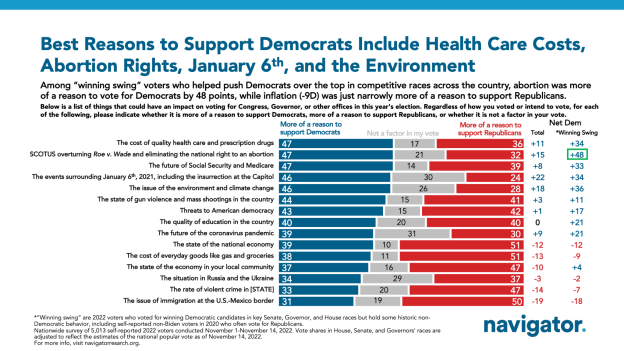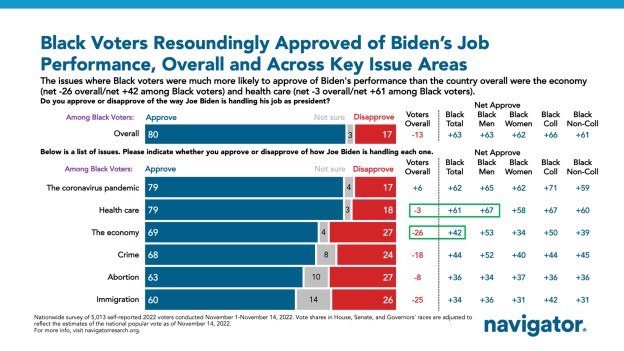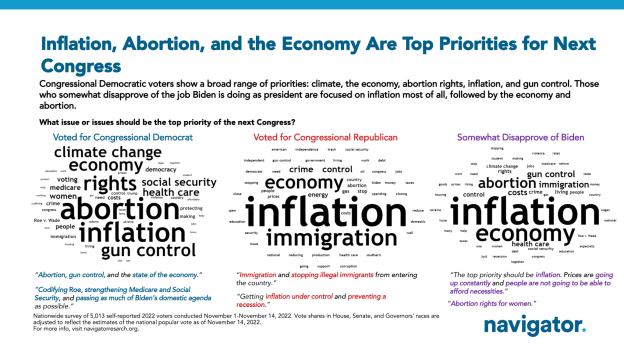WASHINGTON, D.C. — Last November, Navigator Research conducted a survey with over 5,000 midterm election voters to understand which issues affected vote choice and turnout. We distilled these findings into eight different categories: which issues mattered most; support for the two parties; the economy; abortion; youth voters; AAPI voters; Black voters; and Hispanic voters.
As we enter the next two years of a divided Congress, here are our key takeaways from the survey, including what issues drew voters to both parties and what Americans want from their leaders.
While Inflation and Abortion Were Top Issues, Social Security and Medicare Played a Significant Role
-
Almost half of voters (45 percent) named inflation as one of their top issues, with a third of Americans (30 percent) saying the same of abortion. ‘Winning swing’ voters — those who voted for Democrats who won key races but displayed historic non-Democratic behavior — were even more likely to name inflation and abortion as top priorities (49 percent and 35 percent, respectively). However, a third of these voters (31 percent) named Social Security and Medicare as a top priority, compared to just 22 percent of voters overall.

-
Among voters prioritizing economic issues and not abortion (48 percent of the electorate), Republican congressional candidates won by a 45-point margin (26 percent Democratic candidates – 71 percent Republican candidates). However, among the other 52 percent of voters who prioritized abortion (30 percent) or other issues unrelated to the economy, inflation, or abortion (22 percent), Democratic candidates won by a similarly high 40-point margin (68 percent Democratic candidates – 28 percent Republican candidates).
-
Prioritizing abortion was a particularly significant indicator of Democratic support: those who rated abortion, but not economic issues, as a top priority overwhelmingly supported Democrats (80 percent Democratic candidates – 16 percent Republican candidates); among those who prioritized abortion and economic issues, Democrats beat Republicans by a 27-point margin (62 percent Democratic candidates – 35 percent Republican candidates). An additional 22 percent of voters prioritized neither economic issues nor abortion, and these voters also backed Democratic candidates by a 20-point margin, indicating that their top issues were Social Security and Medicare, health care, and democracy.
-
-
Midterm voters were overwhelmingly pro-choice (60 percent; 36 percent identified as “pro-life”) and opposed a national abortion ban (67 percent). Both Republican men and women were evenly divided on their support for nationwide abortion bans, while opposition to a ban was particularly strong among AAPI voters (79 percent), Black voters (73 percent), and Hispanic voters (69 percent).
-
Overall, Americans cited health care costs, abortion rights, and the future of Social Security and Medicare as among the top reasons to support Democrats over Republicans. Additionally, over half of Gen Z voters (58 percent) saw student loan debt as a reason to support Democrats over Republicans. While the top reasons to support Democrats varied by racial demographic, no non-white demographic cited any issue as a reason to support Republicans over Democrats:
-
Around three in five AAPI voters said that climate change (64 percent), health care costs (61 percent), the right to abortion (60 percent), and the Jan. 6th insurrection (60 percent) were reasons to prefer Democrats to Republicans.
-
Black voters overwhelmingly supported Democrats on every issue, citing health care costs (78 percent), the Jan. 6th insurrection, gun violence, and the future of Social Security and Medicare (all 76 percent) as the top reasons to support Democrats.
-
Hispanic voters viewed the future of Social Security and Medicare and the right to abortion as the top reasons to support Democrats (both 58 percent), with climate change and health care costs (both 55 percent) also seen as convincing reasons.
-

-
Older voters were particularly concerned about the future of Social Security and Medicare: a third of Baby Boomers (33 percent) and 40 percent of Silent Generation voters named it as a top priority at the polls. This was also by far the top issue for Black voters over 65, with 56 percent identifying it as a top concern. Since the election, Americans cited cuts to Social Security and Medicare as one of their top concerns with the new Republican Congress.
Biden’s Approval Was Largely Unimportant to Vote Choice, Though Non-White Voters Scored Him Particularly Well
-
President Biden was viewed unfavorably by the majority of midterm voters (56 percent disapprove; 43 percent approve). But Biden’s favorability did not substantially affect vote choice: among voters who ‘somewhat disapproved’ of Biden, 45 percent voted for a Democrat in the House (46 percent voted for a Republican) and 52 percent voted for a Democrat in the Senate (43 percent Republican).
-
Despite the importance of inflation to this election, those who disapproved of Biden’s handling of the economy broke even more favorably for Democrats in both the House (net +36 for Democrats) and the Senate (net +46 for Democrats).
-
-
Overall, voters narrowly preferred Republicans over Democrats in House races (49 percent to 47 percent) and Democrats over Republicans in Senate races (50 percent to 48 percent). In House races, Democrats won the majority of Black voters (86 percent), AAPI voters (62 percent), and Hispanic voters (62 percent). In Senate races, Democrats won by similarly large shares, garnering 86 percent of the Black vote, 67 percent of the AAPI vote, and 60 percent of the Hispanic vote.
-
Among six key issues (the pandemic, health care, abortion, crime, the economy, and immigration), the only issue where Biden scored favorably was his handling of COVID (51 percent). However, the majority of AAPI and Hispanic voters approved of his handling of the pandemic, abortion, and health care. Black voters resoundingly approved of his handling of each issue, including 69 percent who approved of his handling of the economy.

-
Meanwhile, a majority of Americans disapproved of both Donald Trump (57 percent disapprove; 42 percent approve) and MAGA Republicans (54 percent disapprove; 35 percent approve). ‘Winning swing’ voters were particularly negative on Donald Trump (net -30) and MAGA Republicans (net -43).
Americans Want Congress to Focus on Inflation and Abortion Rights, Not Investigations
-
In an open-ended question about which issues the next Congress should prioritize, abortion and inflation were the top responses. While Democratic voters narrowly identified abortion as a top priority over inflation, inflation was the top concern for Republican voters and voters who slightly disapproved of Biden. Those who supported Republicans also named immigration as a top priority. Meanwhile, each of these groups said inflation was the most important issue for both parties to work together on.
-
Navigator polling after the election found that three in five Americans want Congress to focus on lowering costs (76 percent), reducing violent crime (74 percent), and addressing the U.S.-Mexico border (74 percent) instead of investigating the Biden administration. Additionally, nearly nine in ten Americans would prefer Americans work on these issues instead of banning abortion nationwide.

Democrats Were Significantly More Likely Than Republicans To Contact Non-White Voters
-
61 percent of Black voters reported being contacted by Democratic candidates, with 45 percent reporting being contacted multiple times. By contrast, only 36 percent of Black voters were contacted by Republican candidates, with just 22 percent being contacted multiple times.
-
Just over half of Hispanic voters (53 percent) were contacted by Democratic candidates, compared to 40 percent who were contacted by Republican candidates. This gap was driven by Hispanic women (53 percent contacted by Democrats; 37 percent contacted by Republicans) and Hispanic voters ages 18-54 (51 percent contacted by Democrats; 37 percent contacted by Republicans).
-
The majority of AAPI voters were not contacted by candidates from either party, with 52 percent saying they did not hear from Democrats and 68 percent saying the same of Republicans. However, 42 percent of AAPI voters were contacted by Democrats multiple times, compared to just one in four (26 percent) who were contacted by Republicans multiple times.
###
